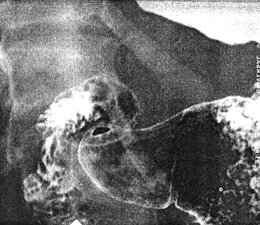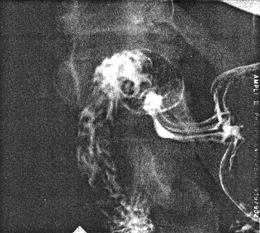


Go to chapter: 1 | 2 | 3 | 4 | 5 | 6 | 7 | 8 | 9 | 10 | 11 | 12 | 13 | 14 | 15 | 16 | 17 | 18 | 19 | 20 | 21 | 22 | 23 | 24 | 25 | 26 | 27 | 28 | 29 | 30 | 31 | 32 | 33 | 34 | 35 | 36 | 37 | 38 | 39
Chapter 13 (page 61)




Go to chapter: 1 | 2 | 3 | 4 | 5 | 6 | 7 | 8 | 9 | 10 | 11 | 12 | 13 | 14 | 15 | 16 | 17 | 18 | 19 | 20 | 21 | 22 | 23 | 24 | 25 | 26 | 27 | 28 | 29 | 30 | 31 | 32 | 33 | 34 | 35 | 36 | 37 | 38 | 39
Chapter 13 (page 61)
A |  B B |
| Fig. 13.15 A,B. Double contrast study. A Sphincteric cylinder relaxed. Pyloric aperture filled with gas and patent. B. Sphincteric cylinder contracted, resulting in formation of pyloric canal and closure of gastric outlet. Note longitudinal mucosal folds in pyloric canal | |
The cases quoted are not exceptions but are examples of numerous other normal cases.
No attempt was made to analyze contractions of the loops statistically. Studies of gastric
emptying were not pursued in greater detail as the investigation is primarily concerned
with the anatomy and movements of the sphincteric cylinder.
Ehrlein (l980) described a technique for simultaneous recording of motility and
radiography in unanaesthetized dogs. Antral and duodenal contractions were recorded
with chronically implanted strain gauge transducers, the external diameter of the pylorus
was measured with induction coils, and radiography was used to measure gastric
emptying, the internal pyloric diameter, and the volume of the "antrum". The right
pyloric loop was called the distal pyloric loop (DPL) or pyloric sphincter, and the left
loop the proximal pyloric loop (PPL); the latter is not as prominent in dogs as it is in
man and certain other vertebrates. The distal 2.5 cm of the antrum was referred to as the
terminal antrum. (Ehrlein's terminal antrum, located between the DPL and PPL,
corresponds to the pyloric sphincteric cylinder located between the right and left pyloric
loops).
Using the above methodology in a number of elegant studies, Ehrlein et al. (l984),
Ehrlein and Akkermans (l984) and Keinke et al. (l984), found the mean frequency of
terminal antral contractions to be 5.1 per minute in dogs. The velocity of each gastric
contraction wave was found to increase during propagation from the proximal part of the
antrum to the pyloric sphincter; during progression from the middle to the terminal
antrum it increased from 0.9 to 1.5 cm per second. Detailed analysis of transducer
recordings revealed a time lag between contraction maxima of the canine terminal antrum
and the distal pyloric loop; contraction maxima at a site 2.5 cm orally to the sphincter
occurred approximately 2.2 seconds before contraction maxima of the sphincter.
According to Ehrlein (l984), it was doubtful whether this sequence should be interpreted
as a systolic contraction of the terminal antrum (as the case appeared to be in
radiography), or as a rapidly progressing peristaltic wave, causing sequential contraction
of the terminal antrum and pyloric sphincter. The final result of the contraction was
complete obliteration of the antral lumen in the last 2.0 to 3.0 cm of the stomach.
(Although different terminology is used, the same final result was found in radiology).
In a study of gastric evacuation of mashed potatoes, Keinke and Ehrlein (l983) found that
the external diameter of the pylorus increased and decreased in sequence with antral
contraction waves. Simultaneous injection of fat (oleic acid) into the duodenum caused
inhibition of antral contractions with delay in gastric emptying. When the contraction
wave travelled over the proximal antrum, the terminal antrum and pylorus began to relax.
When the wave reached the middle of the antrum the pylorus was relaxed, the ingesta
being partly propelled through the pylorus into the duodenum and partly retropelled
through the central opening of the peristaltic constriction into the proximal antrum.
When the gastric wave moved with increasing velocity over the terminal antrum, the
pyloric sphincter began to contract; this enhanced retropulsion of ingesta.
Ehrlein et al. (l984) showed that the "antral wave" could be differentiated into phases of
propagation, of evacuation and retropulsion, and of enhanced retropulsion and grinding.
Two factors were of importance for regulating flow of chyme into the duodenum, namely
the depth of antral constriction waves and the degree of pyloric relaxation; a deep,
constricting antral wave produced a strong propagative force, whereas a shallow
constriction reduced forward flow and enhanced retropulsion. The depth of the antral
wave depended in large measure on the viscosity of gastric contents (Pröve and
Ehrlein l982).
Previous Page | Table of Contents | Next Page
© Copyright PLiG 1998